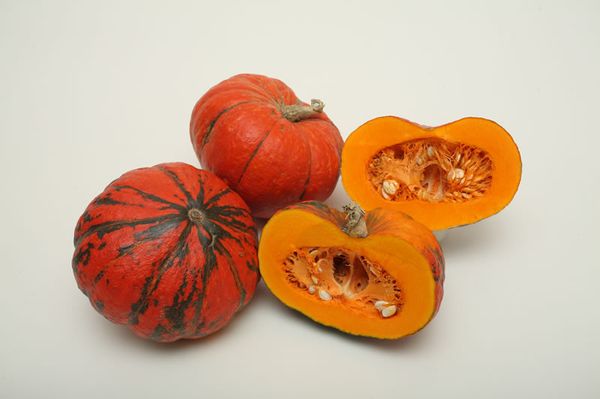The history of pumpkin has more than 7 thousand years, and the culture came to Europe from America in the 16th century. Fell in love with a pleasant sweetish taste, unpretentiousness, the ability for a long time (up to 6 months) to be stored in normal conditions and at the same time preserve taste and healthy qualities. Pumpkin pulp Sweetie contains a lot of useful minerals, vitamins, and pumpkin seeds - a unique product in its chemical composition and benefits to the body.
Table of contents
Description of pumpkin varieties Sweetie
Candy is a selection variety intended for cultivation in large areas of the non-black-earth zone of Russia.
The most important distinctive feature of the fruit - very high sugar content. It is widely cultivated for industrial production of juices and baby food, as well as in homestead plots, summer cottages. Used for cooking first and second courses, sweet desserts and pastries.
According to the description, in a mature form it acquires a beautiful bright orange color, the bark is divided into segments, very dense, thanks to which it is stored for a long time and is easily transported. The flesh is thick, juicy, sugary, red, soft and very sweet.
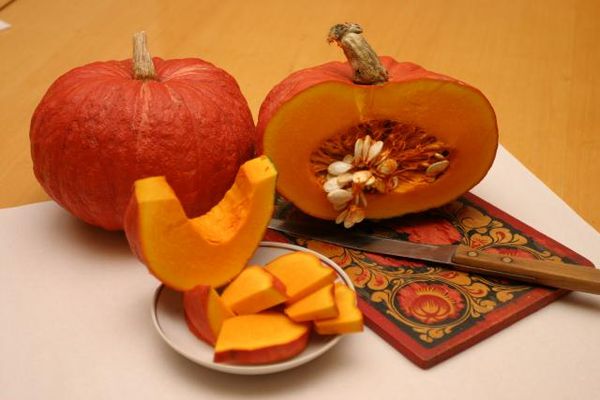
Main characteristics
Pumpkin Sweetie refers to large-fruited middle-ripening varieties. Scourge grows up to one and a half meters in length, 6-8 ovaries are formed on them.The plant is unpretentious, but with good agricultural technology can achieve very high rates.
- High yield. On lashes grows from 6 to 8 fruits, the average weight of which is 1.5-3.0 kg, but there are cases when pumpkins grow to 20, 50 and even 100 kg.
- The nutritional value. Candy contains up to 20% of dry matter, 8% of sugar, a large amount of ascorbic acid and carotene.
- Meaty flesh. She filled almost the entire cavity of the pumpkin. The seed nest is small, the seeds are large, have excellent taste.
With long-term storage, the fruit ripens, the flesh becomes even softer, sweeter and tastier. The variety is considered to be cold-resistant, so it is grown in different regions.
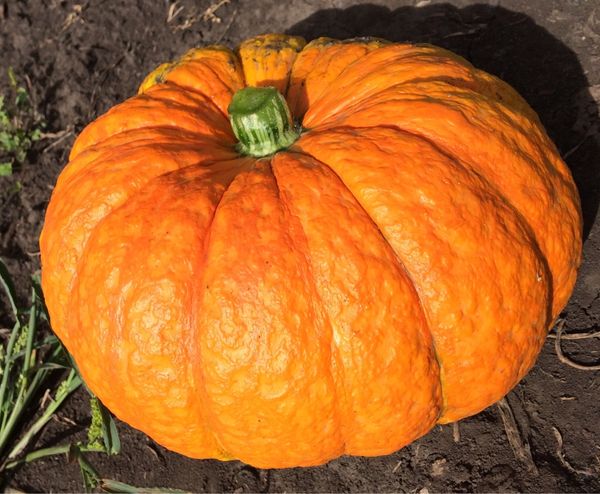
Agrotechnical features of growing pumpkins
Although pumpkin and unpretentious plant, but still, to grow a rich harvest, before sowing seeds it is necessary to make preparatory work.
Preparing the soil
Any pumpkin variety, and especially as fruitful as Yum, loves light loamy soil, well flavored with organic matter (humus or compost - 1 bucket per 1 sq. m). Before sowing, they dig up the ground well, adding organic fertilizer.
If the soil is not fertile enough, 50 g of superphosphate and 1-2 glasses of ash are added to each well.
In warm climatic conditions, where the earth warms up quite early, Candy can be planted as seeds in open ground. In colder conditions, with the late onset of spring, it is better to sprout seedlings in advance.
Seed preparation
For planting material are selected especially high-quality, large and full grains.
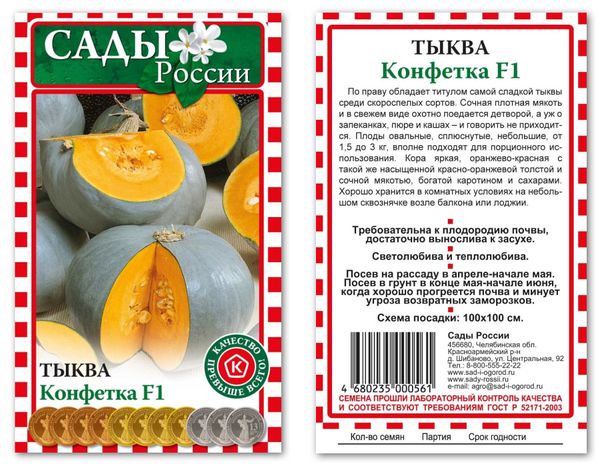
First they are checked for germination: the selected seeds are wrapped in a damp cloth and cleaned for a day in a warm place. Seeds with the best germination rate during this time have time to hatch. Then they are hardened and placed in a refrigerator for several days.
Planting seeds for seedlings
For seedlings, seeds are planted in a separate container, or in wooden boxes, in the prepared soil. Sawdust should be poured into the boxes as drainage, so that when transplanting to a permanent place, the root system is not damaged.
Tara is better to take no bottom and set on pallets.During the landing in open ground, it will be possible to lower the seedlings directly into the hole with a cup, avoiding injury to the roots.
Sowing seeds produce approximately 22-24 days before disembarking to a permanent place (taking into account the local climatic features of the region) + 5 days for shoot, following the following rules:
- pumpkin seeds are sealed to a depth of 3-4 cm, filled with soil, slightly moistened;
- in the box, the distance between the grains must be at least 5x5 cm;
- the container is covered with a transparent film and put in a well-lit warm place until the first shoots appear, then the film is removed;
- with the appearance of 2-3 true leaves, seedlings are planted in open ground, the temperature of which by this time should be at least 13 degrees.
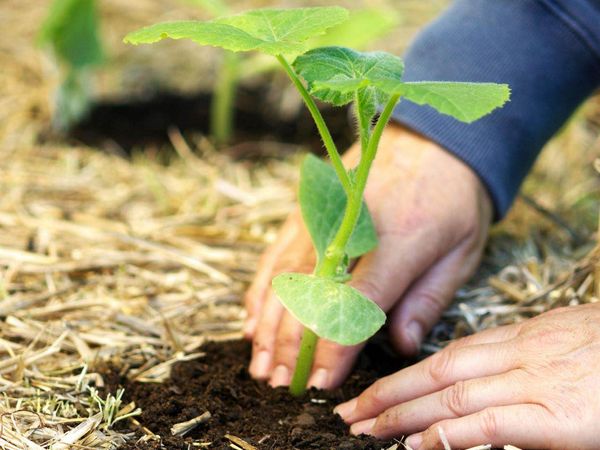
Planting seeds directly into the ground
The earth is already warming up, the shoots are not threatened with frost. In the prepared soil make the hole, moisturize them and put in each 3-4 grains to a depth of about 8 cm.
After the seeds have sprouted, 1 sprout should be left in each well, and the rest should not be pulled out, but carefully cut.This is done because the root system of seedlings is developing rapidly and intertwined with each other, so the sprouts are cut to avoid damaging the root of the remaining shoot.
Pumpkin loves free, warm, well-lit and sun-warmed places. Planted in a permanent place need at the rate of 1 plant per 1 sq. M.
Care and feeding
Plants develop very quickly, so the main care - loosening the soil, weeding, feeding, removing weeds - is carried out before the pumpkin leaves close together.
Pumpkin responds very well to top dressing chicken litter or mulleindiluted with water in a ratio of 1:20 and 1:10, respectively.
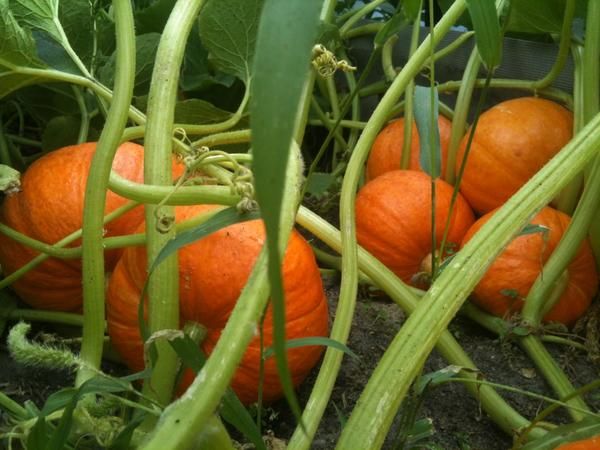
Watered plants with warm water - 20-22 degrees. To obtain large-sized fruits, the lash is clamped, leaving the necessary number of ovaries.
Pumpkin diseases and their prevention
Pumpkin Sweetie, like all pumpkin crops, are prone to diseases:
- bacteriosis;
- white rot;
- root rot;
- powdery mildew.
Affected plants must be treated with appropriate preparations and the basic rule for the prevention of various diseases must be observed. crop rotation. For pumpkin, it is 3-4 years.
Pumpkin Sweetie - a tasty, healthy, unpretentious, easily cultivated vegetable. Excellent taste with low calorie content and weight of nutrients in the composition make it a very popular product in the diet and baby food. That is why the sweet Yummy is the favorite of many gardeners.
